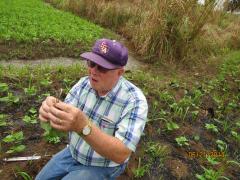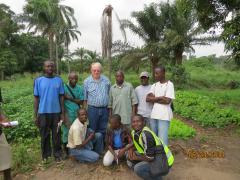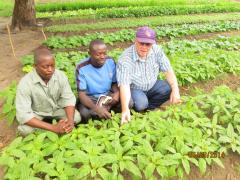
This summer, SFA Professor of Agriculture Dr. Leon Young spent three weeks in Soyo, Angola, teaching farm co-op members methods to improve soil quality through sustainable practices and accessible, affordable resources as a part of CNFA’s Farmer-to-Farmer program.

Dr. Leon Young is pictured with two CNFA Farmer-to-Farmer program participants in their vegetable plots.

Dr. Leon Young and his students take a break from soil fertility lessons to visit their vegetable plots. As a commercial venture in addition to their family's subsistence farms, the men hope to grow leafy vegetables during the dry season to sell to the region's emerging middle class.
“You get off the main thoroughfares in Luanda, and it’s just like any third-world country,” Young explained. “There are people out there living on a shoestring.”
To confront this drastic inequality, CNFA implemented its F2F program in southern Africa with the goal of generating sustained economic growth in the agriculture sector through short-term technical assistance provided by expert volunteers and local staff. The program engages participant needs at every level, from soil fertility to production and marketing.
Young, a professor of agriculture at Stephen F. Austin State University, was tasked with teaching a local famer’s cooperative in Soyo techniques to improve soil quality through sustainable practices and accessible, affordable resources.

Dr. Leon Young inspects Rhizobium nodules on the roots of the common bean plant. Rhizobium are bacteria that form a symbiotic relationship with legume plants to fix nitrogen from the air into the plant, improving soil fertility.
“For a soil fertility guy, that’s really, really frustrating,” Young said.
But Young didn’t have time to remain frustrated. His days were packed with soil sampling and re-evaluating lesson plans to meet the farmers’ needs.
“They’re already doing what they need to do,” he said with a laugh. “I think all I did was give them positive reinforcement.”
Young’s agricultural work in Africa began in 2000 during a church mission trip to Tanzania. While participating in a prayer walk, Young said he overwhelmed a local missionary with questions regarding surrounding crops and agricultural practices.
“I said my agronomy mind is running at 100 miles per hour trying to figure out what is going on here,” Young recollected.
Since then, he has taken part in six other volunteer trips. After teaching the technique of conservation tillage to his first class of Tanzanian farmers, Young purchased a small amount of hybrid corn and nitrogen fertilizer for participants. Those who continue to implement the conservation tillage practices have doubled their corn yields from 25 to 50 bushels per acre.
He joined forces with CNFA in 2013, training workers to run a soil testing lab at the Catholic University of Mozambique. Though he hoped to return to the lab this summer, CNFA representatives explained that his expertise was needed most in Angola.
As the fall semester begins, he is already proposing future trips.
“Well,” he said, pausing to look away from the photos of his students and their crops. “You just feel like you’re doing some good, and it’s a lot of fun.”



